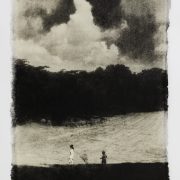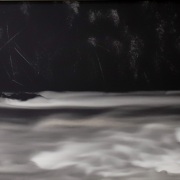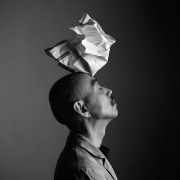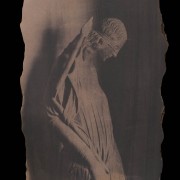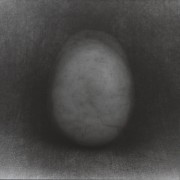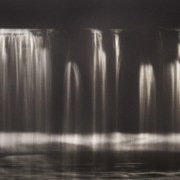Work

The cherry tree holds a special place in the heart of the Japanese, who traditionally celebrate the blossoming of its flowers. After a week of festivities, the petals have fallen and lie scattered on the ground. Indifference re-settles afterwards, but I decided to go back there, alone, to photograph these strewn petals. These photographs are inherently sad, but also gave me hope.
Each frame : 63x53cm, 24,8x20,9inch
Inkjet print on Hahnemühle Museum Etching 350g paper, Wooden frame
Each frame : 63x53cm, 24,8x20,9inch
Inkjet print on Hahnemühle Museum Etching 350g paper, Wooden frame

Waterfalls are a place of mystery for me where I feel an indescribable, inhuman presence that both frightens and intrigues me.
There is a painting entitled “Painting of Nachi waterfall” which, for 14 centuries, was believed to incarnate divinity. The first time I saw this painting, I saw nothing more than an elegant brushstroke on a dark background. Only after did I discover all the details and depth it contained, and renew with my initial, contradictory impression of waterfalls. « Taki » is a contemporary translation of this painting.
100x80cm, 39,4x31,5inch
Gelatin Silver Print, Selenium toning
There is a painting entitled “Painting of Nachi waterfall” which, for 14 centuries, was believed to incarnate divinity. The first time I saw this painting, I saw nothing more than an elegant brushstroke on a dark background. Only after did I discover all the details and depth it contained, and renew with my initial, contradictory impression of waterfalls. « Taki » is a contemporary translation of this painting.
100x80cm, 39,4x31,5inch
Gelatin Silver Print, Selenium toning
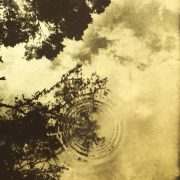
When I was a child in Japan, I used to pick up and collect lots of things while wandering around my house. All these things that I was gathering were pieces of my own valuable treasure. 40 years later, I became a photographer. Today, the way I am working is a lot different from what I used to do during my first years. I determine a concept, I choose a shooting method, I define a dimension and I proceed. I am very methodical. Method is paramount to my creation process.
It has been a year now since I have begun to take pictures with a compact camera, but this time without bothering about the concept, the size or anything else but the act of picking up things, just as I used to do. I am collecting pictures now as I was accumulating things when I was a child. During this past year, I have started to feel a sense of emancipation. I have shot many rolls of film, picking up a considerable number of everyday pieces, artefacts, items or spots that I find interesting. And when I look at my contact sheet with a magnifying glass, my eyes sometimes get caught by a small shining gem. I then choose the good timing, determine the right print format and gem start to shine brighter, just like a diamond being cut and polished. Keeping small dimensions is important. The picture has to remain as little as a diamond. I chose to keep theses dimensions between 5 and 30 centimetres.
The technique used for this series is called “orotone”, which was popularized by the American photographer and ethnologist Edward Curtis (1868-1952), who took his pictures using a derivative of this process to photograph Native Americans. The power of this series is quite impressive. I have decided to adapt this process for my work.
To me, these simple and humble moments are like looking for a kind of precious stone or religious icon. Picking up things which we don't usually see and sublimate them as vaporous relics of a frozen present. These moments are so fugitive, so fragile, so beautiful. Our life is, in the end, an accretion of this kind of moments.
This way of doing things is much like gleaning, to me. And as France is my land of welcome, this is why I entitled this series with the French word “Glanage”. It felt natural, perfectly fit, but also refers, as a tribute, to my family of traditional farmers, back in Japan.
My intention is to pursue this series until my last days. I don't know how long this will be, but it is definitely meant to be a long-term project. And as this collection of gleaned items will grow, hanging on the wall, it will more and more look, from afar, like the Milky Way. A Milky Way that will expand. A golden Milky Way that could be seen a vital lead for my life.
It has been a year now since I have begun to take pictures with a compact camera, but this time without bothering about the concept, the size or anything else but the act of picking up things, just as I used to do. I am collecting pictures now as I was accumulating things when I was a child. During this past year, I have started to feel a sense of emancipation. I have shot many rolls of film, picking up a considerable number of everyday pieces, artefacts, items or spots that I find interesting. And when I look at my contact sheet with a magnifying glass, my eyes sometimes get caught by a small shining gem. I then choose the good timing, determine the right print format and gem start to shine brighter, just like a diamond being cut and polished. Keeping small dimensions is important. The picture has to remain as little as a diamond. I chose to keep theses dimensions between 5 and 30 centimetres.
The technique used for this series is called “orotone”, which was popularized by the American photographer and ethnologist Edward Curtis (1868-1952), who took his pictures using a derivative of this process to photograph Native Americans. The power of this series is quite impressive. I have decided to adapt this process for my work.
To me, these simple and humble moments are like looking for a kind of precious stone or religious icon. Picking up things which we don't usually see and sublimate them as vaporous relics of a frozen present. These moments are so fugitive, so fragile, so beautiful. Our life is, in the end, an accretion of this kind of moments.
This way of doing things is much like gleaning, to me. And as France is my land of welcome, this is why I entitled this series with the French word “Glanage”. It felt natural, perfectly fit, but also refers, as a tribute, to my family of traditional farmers, back in Japan.
My intention is to pursue this series until my last days. I don't know how long this will be, but it is definitely meant to be a long-term project. And as this collection of gleaned items will grow, hanging on the wall, it will more and more look, from afar, like the Milky Way. A Milky Way that will expand. A golden Milky Way that could be seen a vital lead for my life.
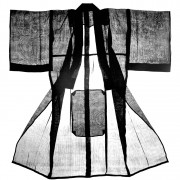
Almost two years have passed since my mother’s death. When I went to Japan last year, I found her kimonos, which she kept after she got married. These keepsakes will soon be shared among my family and I.
I decided to claim these kimonos by making photograms. This simple process involves placing an object on photo-sensitive paper and exposing it to light to capture its shadow.
Using this technique, I was able to capture the shape of the shadow cast by my mother’s kimonos.
197x137cm, 77.6x53.9inch
Tirage argentique, Photogram Photogramme, Contre collage sur Dibond
I decided to claim these kimonos by making photograms. This simple process involves placing an object on photo-sensitive paper and exposing it to light to capture its shadow.
Using this technique, I was able to capture the shape of the shadow cast by my mother’s kimonos.
197x137cm, 77.6x53.9inch
Tirage argentique, Photogram Photogramme, Contre collage sur Dibond

Un jour, un ami m'a dit que nous étions comme des poissons qui doivent continuer à nager contre le courant sans savoir pourquoi.
Un ruisseau passe devant chez moi au Japon. Aujourd'hui, il est très sale. Mais il y a toujours des carpes qui remontent vers la source au printemps. Depuis qu'il m'a parlé des poissons, une sorte de connivence amicale s'est installée entre les carpes et moi.
J'ai commencé à photographier ces carpes qui nagent à contre-courant. D'abord devant chez moi, puis dans les alentours.
J'ai choisi comme support le papier Minowashi. C'est un papier traditionnel fabriqué dans l'eau qui descend de la même région que mon ruisseau, la région montagneuse de Gifu. Fixer l'image de ces carpes sur ce papier m'a paru très beau.
98x32cm, 38,6x12,6inch
Gelatin Silver Print on Minowashi
Un ruisseau passe devant chez moi au Japon. Aujourd'hui, il est très sale. Mais il y a toujours des carpes qui remontent vers la source au printemps. Depuis qu'il m'a parlé des poissons, une sorte de connivence amicale s'est installée entre les carpes et moi.
J'ai commencé à photographier ces carpes qui nagent à contre-courant. D'abord devant chez moi, puis dans les alentours.
J'ai choisi comme support le papier Minowashi. C'est un papier traditionnel fabriqué dans l'eau qui descend de la même région que mon ruisseau, la région montagneuse de Gifu. Fixer l'image de ces carpes sur ce papier m'a paru très beau.
98x32cm, 38,6x12,6inch
Gelatin Silver Print on Minowashi
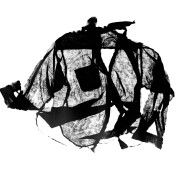
These portraits are photograms. The idea was to eliminate
as many barriers between the subject and the photograph
as possible to add force to the shot, using neither
a camera nor film. Despite this direct process, the result
is closer to death than life. The people in these portraits
have evaporated…
100x96cm, 9,4x39,4inch
Gelatin Silver Print Mounted on Dibond
as many barriers between the subject and the photograph
as possible to add force to the shot, using neither
a camera nor film. Despite this direct process, the result
is closer to death than life. The people in these portraits
have evaporated…
100x96cm, 9,4x39,4inch
Gelatin Silver Print Mounted on Dibond

Lighting a candle in a sacred place and saying a prayer is a ritual performed all over the world. I photographed this ceremony in a church and again in a Buddhist temple. In my photographs, the candles, which burn for just a few hours, are sparkling, whereas the people have almost disappeared, as if already in the hereafter. I found this shifting effect particularly interesting.
32x40cm, 12.6x15.7inch
Gelatin Silver Print
32x40cm, 12.6x15.7inch
Gelatin Silver Print
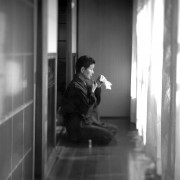
I returned to Japan twice in 2003. My mother was suffering from a terrible illness. Despite these grim circumstances, nothing in my family’s daily life seemed to have changed. It seemed as cruel as it was beautiful. This life, to which I had never paid attention, revealed its power to me. I shot it without thinking, intuitively, in the familiar space of my home. Its vulnerability became mine. When I look at these pictures, something whispers on the paper and I can’t look away. It’s so peaceful. At times, though, it grips my heart…
37x37cm, 14.5x14,5inch
Gelatin Silver Print
37x37cm, 14.5x14,5inch
Gelatin Silver Print
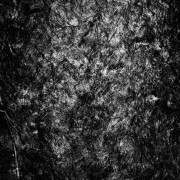
I first visited Sainte-Marie-aux-Mines on a stormy day. There was no one in the street and the sky loomed overhead. I was taken by the atmosphere. I looked at the river that runs along the road – the Liepvrette, which crosses the valley. The movement and sound of the water consoled me.
For me, the Liepvrette river is the identity of Sainte-Marie-aux-Mines. The sound of its water is like an intermediary between the river and the town’s residents.
It runs through the valley like a spinal cord. The mineral washing and fabric making that helped this village prosper were made possible by this river, which today flows discretely through town and is less important than before. Nevertheless, it continues to console the hearts of those who live here, all along its course – myself included, in fact. I grew up in a house on the edge of a small river with the sound of water in my ears. This sound is engraved in my memory. When I close my eyes, it wells up from the bottom of my heart.
I began by shooting the surface of the Liepvrette from every bridge in Sainte-Marie-aux-Mines.
122x100cm, 48×39,4inch
Inkjet Print
For me, the Liepvrette river is the identity of Sainte-Marie-aux-Mines. The sound of its water is like an intermediary between the river and the town’s residents.
It runs through the valley like a spinal cord. The mineral washing and fabric making that helped this village prosper were made possible by this river, which today flows discretely through town and is less important than before. Nevertheless, it continues to console the hearts of those who live here, all along its course – myself included, in fact. I grew up in a house on the edge of a small river with the sound of water in my ears. This sound is engraved in my memory. When I close my eyes, it wells up from the bottom of my heart.
I began by shooting the surface of the Liepvrette from every bridge in Sainte-Marie-aux-Mines.
122x100cm, 48×39,4inch
Inkjet Print
Copyright 2024
